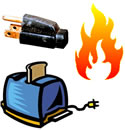 Electric fires are becoming more common as appliances and electric feeds are used more and more in our daily lives. Like other fires, the root cause of an electric fire is the introduction of heat, oxygen, and fuel. In electrical fires, the heat is released as electricity is dissipated through a resistive element, while the fuel may come from the surroundings or from the material that makes up the appliance. When analyzing an electrical fire, it is important to find the origin of the fire as well as the safety precautions that could have prevented the fire. Some common causes of electrical fires and explosions include insufficient insulation and improper grounding.
Electric fires are becoming more common as appliances and electric feeds are used more and more in our daily lives. Like other fires, the root cause of an electric fire is the introduction of heat, oxygen, and fuel. In electrical fires, the heat is released as electricity is dissipated through a resistive element, while the fuel may come from the surroundings or from the material that makes up the appliance. When analyzing an electrical fire, it is important to find the origin of the fire as well as the safety precautions that could have prevented the fire. Some common causes of electrical fires and explosions include insufficient insulation and improper grounding.
Expertise
We have experience in many aspects of electrical fires and explosions including:
- Measuring and testing appliances and their components to trace the cause and origin of fire
- A reference library including electrical standards and codes
- Measuring operating parameters and comparing these to pre-fire values
Questions Answered
Through scientific analysis, we can help you answer pertinent questions such as:
- Where did the fire start and what was its cause?
- Was the building wiring adequate?
- What precautions could have been taken to prevent this explosion?
- What damage was caused by the fire and what was caused by other events?
Case Examples
Circuit Breaker Explosion:
A man was exposed to 4000 amps when he accidentally dropped his screwdriver into a live industrial electrical panel. When this happened, several metal parts in the circuit box vaporized causing an explosion. Initially, he was thought to have suffered an electric shock. Our investigation revealed that his injuries had all been caused by secondary explosions. He was not hurt directly by the electricity in any way. This information was needed to show that the wiring installation was not sufficiently grounded.
Aquarium Fire:
A pet store sold a "complete" aquarium to a homeowner, including setup and periodic maintenance. There was a fire and we were hired to determine the cause of the fire. We discovered that the homeowner had used electrical cables specifically NOT rated for use in a damp environment, and that one of these cables caused the fire. This demonstrated that neither the aquarium installation nor the aquarium products were defective and the fire was a result of the Plaintiff's own improper actions.
Kristopher J. Seluga, PE, is a Mechanical Engineering, Accident Reconstruction, Biomechanics, and Safety Expert with over 20 years of experience. He received his Bachelor's and Master's degrees from the Mechanical Engineering department at MIT where he worked on the development of novel three-dimensional printing technologies. Mr. Seluga is also a licensed Professional Engineer in New York and Connecticut, and has served as a member of the ANSI engineering committee for the Z130.1 and Z135 standards for golf cars and PTV's. His research interests and peer reviewed publications span the topics of Motor Vehicle Dynamics, Product Safety, and Biomechanics.
©Copyright - All Rights Reserved
DO NOT REPRODUCE WITHOUT WRITTEN PERMISSION BY AUTHOR.



 Electric fires are becoming more common as appliances and electric feeds are used more and more in our daily lives. Like other fires, the root cause of an electric fire is the introduction of heat, oxygen, and fuel. In electrical fires, the heat is released as electricity is dissipated through a resistive element, while the fuel may come from the surroundings or from the material that makes up the appliance. When analyzing an electrical fire, it is important to find the origin of the fire as well as the safety precautions that could have prevented the fire. Some common causes of electrical fires and explosions include insufficient insulation and improper grounding.
Electric fires are becoming more common as appliances and electric feeds are used more and more in our daily lives. Like other fires, the root cause of an electric fire is the introduction of heat, oxygen, and fuel. In electrical fires, the heat is released as electricity is dissipated through a resistive element, while the fuel may come from the surroundings or from the material that makes up the appliance. When analyzing an electrical fire, it is important to find the origin of the fire as well as the safety precautions that could have prevented the fire. Some common causes of electrical fires and explosions include insufficient insulation and improper grounding.








